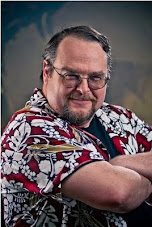So I was talking about Free Comic Book Day a while back, and I mentioned the DC giveaway, Darkest Night, which was a promotion for the upcoming major event of the same name. And it is a pretty good tease, in that it raises my interest in at least the core books of the series, but it does underscore several challenges to serial story continuity in general and to DC in particular.
Here's the book in brief. Hal (Green Lantern) Jordan and Barry (Flash) Allen gather at the grave of Bruce (Batman) Wayne and talk about death and mortality. In the course of it, they mention they have both been previously dead, along with a bunch of the current DC pantheon. A supervillain, the Black Hand, is watching the conversation, and after the heroes leave, decides to raise someone from the dead to be part of his "Black Lanterns" (though the exact "who" is up in the air, as it is a bit confusing).
The back half of the book is a tour through the rainbow of various lantern corps, but that's a problem for another day. The thing to note here is that both of the main protagonists have been dead previously. Dead and replaced by younger individuals. Dead and supposedly never to be replaced.
And yet, here they are. Standing over the grave of another deceased hero, who has a timer on his gravestone for his eventual return. And Hal even lost his "grey-at-the-temples" look.
Now, there is a behind-the-scenes reason for this, involving the balance between backstory and nostalgia. Both Hal and Barry were Silver Age heroes, meaning they showed up in the fifties and early sixties. As time progressed, the people who locked in on those characters got older, and the heroes seemed less relevant and more clogged with history. So Barry Allen died in the Crisis on Infinite Earths, and was replaced by his former sidekick, Wally (Kid Flash) West. Hal got a shoddier deal, going crazy, blowing up a lot of stuff, before eventually sacrificing himself as well in some lame followup (and eventually became the replacement for ANOTHER superhero, the Spectre).
OK, tempus fugit. Time marches on. And though I read the Barry and Hal versions back as a kid (Green Lantern drawn by Gil Kane, Flash by Carmin Infantino, who drew his characters with chins sharp enough to open soup cans), I was willing to follow up with the new guys. In fact, the new Flash books were much more interesting than the originals, and I came to like Kyle Raynor as the "last Green Lantern" (something else that did not stick).
So what happened? Why are Hal and Barry back? I think part of it is that there was an age bracket of fans who DID feel that the heroes were taken from them too soon, and it took the passing of years to get these fans to the decision making level with the controlling media company. So looking at the slumping sales of the replacements (actually All Comics have sales that are slumping - it is the nature of that particular beast), they could reasonable speak of the resurrection of the old traditionals.
And so Hal and Barry are back, joining the legions of the formerly dead (Superman, Green Arrow) and those cuing in the anteroom (Martian Manhunter, Aquaman, Firestorm). And just for clarification, I'm not talking about staged deaths, one-issue deaths, dreams, elseworlds, or imaginary stories. I'm talking about long-term yep-the-hero's-gone throw-the-funeral deaths. In fact, I think only Wonder Woman hasn't been dead-dead of the DC Pantheon.
Zombies. The entire DC Universe is now made up of restless dead. Probably not something you really want to think about, but it is the unfortunate result of the continuing and opposing forces of backstory versus nostalgia as a drive for making comic book stories.
More later,
My Newest Publication: DARK TOWER
-
*So, *
So, one of the things I saw at GaryCon that interested me greatly was the
new expanded edition of *DARK TOWER*, by the late great Jennnell Jaquay...
1 day ago


